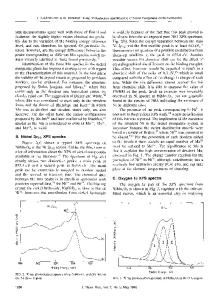Fabrication of nickel manganese cobalt oxide (NMCO) anodes for lithium-ion batteries via hydrothermal process
- PDF / 3,406,352 Bytes
- 11 Pages / 595.276 x 790.866 pts Page_size
- 90 Downloads / 366 Views
RESEARCH ARTICLE
Fabrication of nickel manganese cobalt oxide (NMCO) anodes for lithium‑ion batteries via hydrothermal process Reyhan Solmaz1 · B. Deniz Karahan2 · Ozgul Keles1 Received: 27 December 2019 / Accepted: 28 July 2020 © Springer Nature B.V. 2020
Abstract Nickel manganese cobalt oxide (NMCO) powders have been fabricated by hydrothermal method followed by a calcination. The present work reports for the first time in the open literature, the effects of ammonium fluoride (NH4F) amount and calcination temperature on the NMCO powder’s size and morphology. In this regard, the NMCO composite powders are designed to optimize their performances as anode materials for lithium ion batteries. The morphology, composition and structure of powders have been characterized by scanning electron microscopy, X-ray fluorescence and X-ray diffractometry, respectively. Cyclic voltammetry, galvanostatic and impedance spectroscopy tests have been employed to investigate the lithiation mechanism of the composite electrode. The results reveal that the lowest amount of N H4F (1.5 mmol) in the precursor solution and the lowest calcination temperature (250 °C) lead to form NMCO rods with 100 nm diameter and 3–5 µm length. This newly designed rod-shaped NMCO powder presents a high rate performance. The average discharge/ charge capacities are 1224/1129, 968/939, 856/826, and 744/712 mAh g−1 when the current load increases from 50 to 100, 200 and 400 mA g−1, respectively. Graphic Abstract
Keywords Lithium-ion battery · Anode · Hydrothermal method · Nickel manganese cobalt oxide · NMCO * B. Deniz Karahan [email protected]
1 Introduction
* Ozgul Keles [email protected]
Lithium-ion batteries (LIBs) as a high efficiency clean energy storage system, have been widely used in portable electronic devices, medical science and electrical vehicles [1]. Recently, studies to replace the-state-of-the-art electrode materials (graphite and LiCoO2) have been accelerated [2]. In this perspective, researches to improve the electrochemical performances of transitional metal
1
Department of Metallurgical and Materials Engineering, Istanbul Technical University, 34469 Maslak, Istanbul, Turkey
School of Engineering and Natural Sciences, Civil Engineering Department, Istanbul Medipol University, 34810 Beykoz, Istanbul, Turkey
2
13
Vol.:(0123456789)
oxides (TMOs) as negative electrode materials of LIBs stand out due to their high theoretical capacities (700–1000 mAh g −1) [3–7]. However, the intrinsic low electron conductivity of TMOs and great volume changes occur upon cycling lead weak rate performances and failures at early cycles [8]. As a solution, some scientists have proposed to use binary metal oxides (i.e. N iCo2O4, ZnCo2O4 and M nCo2O4) instead of single TMO because the synergic effects of multiple metal cations provide better electrochemical performance and higher electrical conductivity [4–6]. Venkateswarlu et al. have synthesized CoMn2O4 on a nickel foam substrate and they have also prepared the parent
Data Loading...











